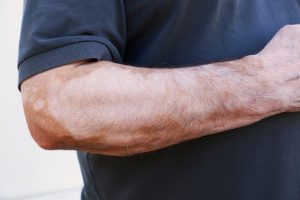
Some key points to a vitiligo diet include, boosting the immune system with foods rich in phytochemicals, beta carotene, and antioxidants to slow down disease progression; avoiding foods that contain hydroquinones, which have depigmentation properties; avoiding citrus fruits and turmeric as they can result in additional skin problems; and avoiding red meat and dairy, especially if you have an allergy, as they can negatively impact your vitiligo.
Furthermore, it’s important to overcome nutritional deficiencies, as extensive research has shown that patients with vitiligo often have deficiencies in vitamin B12, zinc, and copper. Having your levels checked can help you combat these deficiencies and support overall good health.
Vitiligo diet chart: What to eat and avoid
Here is a quick and easy reference chart you can refer to in order to know what to eat and what to avoid when it comes to eating a vitiligo diet.
| What to eat | What to avoid |
|---|---|
| Radish | Oranges |
| Beet root | Pears |
| Carrot | Blueberries |
| French beans | Guava |
| Fenugreek | Prunes |
| Spinach | Grapes |
| Onions | Cashew nuts |
| Mangoes | Watermelon and other melons |
| Walnuts | Papaya |
| Apricots | Lemon |
| Dates | Tomato |
| Wheat | Garlic |
| Pure ghee | Milk |
| Red pepper | Alcohol |
| Pistachio | Buttermilk |
| Almonds | Fish |
| Potatoes | Red meat, beef |
| Chickpeas | Junk food, including chocolate |
| Figs | Caffeine |
| Green leafy vegetables | Soda |
| Whole grains | Oily and spicy food |
Vitiligo food allergies and antioxidants
It is important to be mindful of any food allergies when embarking on a vitiligo diet. Even if a food is in the “what to eat” section, if you are allergic to it you should still avoid it. Even minor allergies can make vitiligo worse.
To rule out any possible allergies, it is best to get tested in order to know for sure what foods you should steer clear of.
Antioxidants should also be taken into consideration as they are necessary to fight off free radical damage. Fruits and vegetables are a good source of antioxidants. On the other hand, you should avoid grilled or processed foods as they contain chemicals that can deplete antioxidants in your body.
Other recovery tips for vitiligo
Along with a vitiligo diet, there are other methods you can use to improve your condition. For example, it’s important to enjoy sunlight as it helps the body absorb nutrients more effectively. It’s important to practice proper sun safety measures to ensure you don’t cause any other complications. The sunlight can also help darken the whiter patches brought on by vitiligo.
Your diet should also be high in omega-3 fatty acids, vitamin B12, vitamin D (which can also be obtained through sunlight). Consume organic eggs, manage your stress, and get adequate sleep nightly.
Eating a vitiligo-friendly diet can also work to improve your overall health, so it doesn’t hurt to eat well not only for your vitiligo but for your longevity, too.